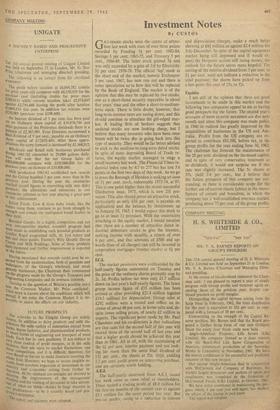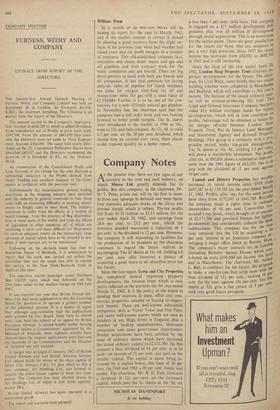Investment Notes
By CUSTOS
GILT-EDGED stocks were the centre of attrac- tion last week with rises of over three points recorded by Funding 5/ per cent. 1982-84, Savings 3 per cent. 1965-75, and Treasury 5 per cent, 1986-89. The latter stock gained 3* and was only exceeded by a gain of 311- by Electricity 31 per cent. 1976-79. The official 'tap' stock at the short end of the market, namely Exchequer 5 per cent. 1967, has now run out and there is some speculation as to how this will be replaced by the Bank of England. The market is of the opinion that this may be replaced by two stocks, one as a short-dated security repayable in about five years' time and the other a short-to-medium- term stock. There is little doubt, however, that long-term interest rates are easing down, and this should continue to stimulate the gilt-edged mar- ket. A leading firm of brokers suggests that undated stocks are now looking cheap, but I believe that many investors who have been once bitten will be twice shy in going back into this type of security. They would be far better advised to stick to the medium-to-long-term dated stocks. In spite of more depressing Board of Trade re- turns, the equity market managed to stage a small recovery last week. The Financial Times in- dustrial index rose by 4.7 to 277 but has lost 5.6 points in the first two days of this week. As we go to press the Borough of Hendon is making an issue of 51 per cent. stock, redeemable 1973-74, at 97. This is one point higher than the recent successful Dunbarton issue, 1975, which is now 2-Fa pre- mium. This also should prove an attractive stock, particularly as only £10 per cent. is payable on application and the balance, by instalments up to January 15, 1963. I would expect this stock to go to at least 1/ premium. With the uncertainty attaching to the equity market, I would mention that there arc a number of attractive dated in- dustrial debenture stocks to give the investor, seeking income with security, a return of over
6 per cent., and that amounts of £500 and up- wards (free of all charges) can still be invested in corporation mortgages (trustee stocks) at 61 per cent.
I.C.1.
The market pessimists were confounded by the half-yearly figures announced on Tuesday and the price of the ordinary shares promptly rose by 2s. 3d. Profits before tax were only £1.7 mlion down on last year's half-yearly figures. The latest group income figure of £35 million has been arrived at after providing £21.4 million (against £19.3 million) for depreciation. Group sales at £292 million were a record and reflect an in- crease of about 40 per cent. in home sales and, de- spite lower selling prices, of nearly £2 million in exports. The significant point made by Mr. Paul Chambers and his co-directors is that indications are that sales for the second half of this year will exceed those of the second half of last year and that a higher profit should be achieved this year than in 1961. All in all, with the maintaining of the 6;1 per cent. interim payment and not look- ing for more than the same final dividend of 131 per cent., the shares at 52s. 10;d. yielding 5./ per cent. could prove an interesting purchase, and are certainly worth holding.
The half-yearly statement from A.E.1. issued last week came as some relief to shareholders. These record a trading profit of £8.9. million for the first six months of the current year as against £9.1 million for the same period last year. But pre-tax profits, ow ing to a reduction in interest
and depreciation charges, make a much better showing at £4/ million as against £2.4 million for July-December. In spite of the capital equipment market being still depressed and (I would ex- pect) the Hotpoint section still losing money,-the outlook for the future seems more hopeful. The cutting of the interim dividend from 5 per cent. to 3+ per cent. need not indicate a reduction in the total payment; the shares have picked up from a low point this year of 23s. to 32s.
Equities
I am still of the opinion that there are good investments to be made in this market and the following two companies appeal to me as having good prospects for the future. The second year's accounts of PENN ELASTIC HOLDINGS are due next month and since this company was made public in 1960 its outlook has greatly improved by the acquisitions of businesses in the US and Aus- tralia. Profits from the US company are ex- pected to contribute £83,500, before tax, to the group profits for the year ending June 30, 1962. The chairman has forecast the maintenance of the 25 per cent. dividend on the increased capital, and in spite of very conservative treatment as to dividends, it would not surprise me if this rate was slightly increased. The 5s. shares at 37s. yield 3.4 per cent., but I believe that the future prospects of this company are out- standing, as there is considerable scope for the further use of narrow elastic fabrics in the manu- facture of corsets and brassieres, in which the company has a well-established overseas market, producing about 75 per cent. of the group profits.
William Press
In a month or SO WILLIAM PRESS will be issuing its report for the year to March, 1962; and if the market rumour is correct it should be showing a good recovery from the slight set- back of the previous year when bad weather had raised costs and cut profit margins in a number of contracts. This old-established company lays, maintains and cleans water mains and gas and .oil pipelines and does contract work for the water companies and gas boards, There are big developments in hand with both gas boards and oil companies. It has had contracts for laying sixty-six miles of pipeline for liquid methane, ten miles for oxygen, sixty-four for oil and twenty-four miles for gas with a total value of £1,550,000. Further it is to be one of the con- tractors for a new 325-mile natural gas pipeline. In November last the chairman said that the company had a full order book and was looking forward to better profit margins. The 4s. shares were introduced to the market in 1960 at 16s., went to 22s. and then relapsed. At 17s. 6d. to yield 4.5 per cent. on the 20 per cent. dividend, which should now be covered over twice, these shares could respond quickly to a better report.



































 Previous page
Previous page